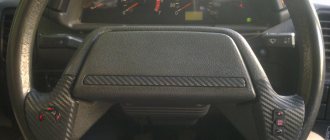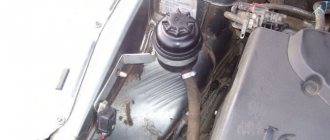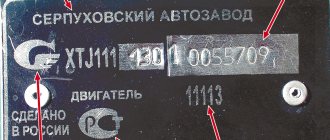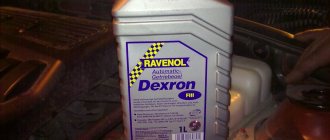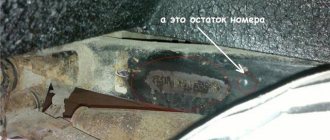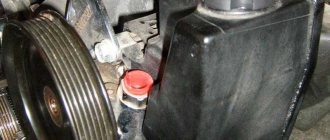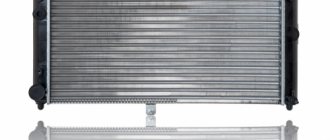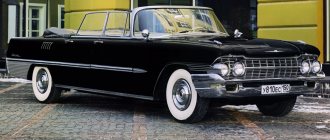01/26/2022 2 160 VAZ 2110
Author: Ivan Baranov
The purpose of the power steering, whether power steering or electric power steering, is to ensure more comfortable and smooth rotation of the steering wheel when performing maneuvers. For a long time, domestically produced cars were not equipped with amplifiers, so many car owners decide to install electric power steering on the VAZ 2110 themselves. You can read more about what this device is and how to install it on your car below.
[Hide]
Detailed guide to installing electric power steering on a “Ten”
The amplifier installation procedure is as follows:
- First you need to take the purchased wires and remove the standard terminal from the connector, and then install it into the connector on the harness.
- The terminal connected to the connector is mounted where the wire was connected to the standard block. This must be done so that you have the opportunity to pass a standard cable between the bundles. It is also necessary to take into account that the wire from the blocks carries 50 amperes; accordingly, it is necessary to install the same safety element.
- The next step will be to remove the steering column trim, ignition switch, and all switches located under the steering wheel. At this stage, you need to do everything carefully, since the lining itself is fragile and can crack.
- Then the screw securing the rail is unscrewed, after which it is removed. Next, you will need to compare the length of the old and new intermediate shafts, since adjustments will need to be made to the plates and the shaft itself. The further fitting procedure is carried out by turning - it is best to perform it on a machine, this will allow you to obtain the most accurate result. We recommend that you contact specialists for this task. As for the dimensions of the plate, they are adjusted by re-drilling some holes to a greater depth. In addition, you may also need to trim the corners of the plate a little with a grinder, after which you will need to install spacers between it and the car body.
- Install the amplifier along with the rail and plate - it is possible that a standard screw will not fit for fixation, so you will have to install a shorter bolt instead. In turn, this may lead to the need to install a limiter to prevent arbitrary rotation of the shaft.
- Next, the central part of the switches is installed.
- After this, two wires are laid from the vehicle interior to the battery; it is advisable to lay the wiring through the left fender. The expansion tank of the washer system is being dismantled. You need to find a long copper wire, with its help you will push the wiring. Then open the mounting block with the safety elements and find the wires that go into the engine compartment, you will need to push the wire through the same hole. Be careful not to damage the wiring. Once the wire comes out through the left fender, attach the amplifier wires to it and push them into the engine compartment.
- Then the control panel is dismantled, having done this, you need to find the red connector. Next, the wiring from the amplifier is pushed into the space under the shield. It is necessary to disconnect the orange cable from the red connector; a block from the set of wires for the electric power steering is installed on it. This wire should be connected to the orange wiring of the installed system, and the remaining end with the terminal is mounted instead of the standard cable in the connector.
- Similar actions are carried out with the gray wire; it is also installed in the red connector. The cables routed into the engine compartment must be connected as follows: the black wire is connected to the negative, the pink wire to the positive. Actually, at this point the installation procedure can be considered complete. Now you only need to reinstall the cover and steering wheel.
Replacing hoses and oil
Power steering hoses are an important part of it. Therefore, they need an eye and an eye. But what if they still need to be replaced? Should you take your car to a service station? Of course, there is no need, because you can do all this yourself. Usually, hoses are replaced simultaneously with the power steering oil change. And it would be opportune to present joint instructions.
- First you need to lift both front wheels of the car (they should be in the air);
- We find the power steering reservoir from which the oil should be pumped out;
- Pump out the oil;
- Turn the steering wheel all the way in any direction (after this oil will appear in the tank again, which needs to be pumped out again);
- Now turn the steering wheel in the other direction and pump out the oil again;
- We remove the hose, which is the oil conductor (through it, the oil comes from the passenger compartment and enters the tank);
- Turn the steering wheel from side to side (oil should come out again);
Replacing power steering oil
- We take new power steering oil (usually about 800 ml);
- Fill it into the tank to the maximum level;
- Again, turn the steering wheel from side to side (all the way);
- We start the engine for a few seconds, turn it off;
- We turn the steering wheel again;
- Add oil;
- We pump and remove air from the system by turning the steering wheel with the car turned off ten times in each direction (we do the same number of times with the engine running).
When changing the oil, be sure to look at all hoses and pipes. If oil is leaking, this is a sign of a torn or faulty hose that will need to be replaced. Hoses are replaced only after the oil has been completely pumped out. You will need to unscrew the clamps and remove the hoses from the pump. As for installation, new hoses and pipes should be tightened with clamps and not overdo it (hoses easily burst, if anything happens).
Component Benefits
The electric steering wheel has a number of advantages, which led to the fact that it is installed not only on the VAZ 2110, but also on other models of this plant. In addition to technical characteristics, it has other equally important indicators:
- Simplicity of installation work when installing the unit;
- The unit consumes a relatively small amount of electricity;
- The unit does not affect the environmental performance of the car;
- Possible installation of the unit on other VAZ models;
- Parametric indicators, that is, an effective reduction in torque according to an increase in vehicle speed;
- During operation, no additional care or use of various special materials is required;
- At low temperatures, this option for strengthening the steering wheel performs better.
The only drawback of this device is the fact that it works a little weaker than the same hydraulic booster.
New electric power steering VAZ 2110 with components
But in the case of domestic roads, this gain is quite enough to feel comfortable behind the wheel.
Installation of EUR
Required Tools
Let's say you purchased an EUR kit - it could be from a VAZ 2110 or from another model, for example, from a Priora. Prepare the following tools:
- Drill together with a metal drill.
- Set of screwdrivers, grinder.
- Long ruler.
All is ready? Let's move on to installation.
Step-by-step instruction
- You need to remove the standard terminal from the block and place it in the block on the harness. We find the standard drive, which is attached to the block. A free terminal must be installed in its place. Now the wire can be placed between the fasteners.
Adjustment
After assembly, you will need to straighten the steering wheel if it is installed crooked. Separately install the sensor that came with the EUR. If the column casing is cracked, it is better to immediately replace it with a good one. There may be gaps between the front panel and the casing - they must be removed.
Operating principle of EUR and power steering
Power steering VAZ 2110 is a system consisting of many elements. The power steering pump in this case is driven by the crankshaft - it pumps oil, as a result of which, through pressure, it allows rotation of the steering wheel.
The electric power steering is a modular design that is built into the steering column; the module itself consists of:
- synchronous type electric motor;
- torsion bar;
- several sensors;
- control module.
EUR device for a VAZ car
The principle of operation is as follows - the torsion bar is twisted, the sensor reads the torque, and the electric motor transmits a small force to the output shaft.
How to install power steering on a VAZ 2110
AvtoVAZ installed two steering systems on LADA cars of the tenth family: electric power steering (EPS) or hydraulic booster (GUR).
However, the majority of cars did not have power steering, but if desired, the car can be modified by installing power steering on a VAZ 2110 with your own hands.. It will be required . buy a power steering kit (in online stores the price is more than 20 thousand rubles), which consists of a pump and its mount, hoses, a reservoir, a steering rack, a generator mount (you can modify the mount for a c/o air conditioner), a tension roller and its bracket, power steering belt (6PK1115). It is also worth choosing power steering fluid.
Installing the tension roller:
- Remove the timing case, install the bracket with 3 bolts, screwing them into the existing holes. Install a pin under the roller on the bracket.
- Make a hole in the timing case for the pulley stud.
- Install the roller onto the stud.
- Remove the generator and both mountings (report).
- Remove the steering column.
- Shorten the steering shaft by about 3.5 cm using a grinder and welding.
We are finalizing the power steering pump mount:
- We saw off the excess, as shown in the photo.
- We attach the pump to the bracket and the pillow to it. We install everything assembled on the engine, where the lower mount of the generator used to be.
Install the power steering belt and reservoir:
- Unscrew the engine mount bolt and lift the engine (report).
- We insert the belt into the resulting hole. We install it on the tension roller.
- We install the power steering reservoir mounts under the adsorber mount.
We change the steering rack to a rack with power steering (types of VAZ steering racks):
- Remove the tie rod ends and unscrew the 4 rack mounting bolts. Pull the rack out through the right hole in the steering ends.
- We install the power steering steering rack (report), after unscrewing the extra element (see photo).
All that remains is to fill the power steering fluid and check the operation of the system. By the way, many people prefer to install electric power steering instead of power steering.
Differences between EUR and power steering
These are completely different units. To understand the main differences, it is enough to study the hydraulic booster. Its main component is a pump driven by the crankshaft, it is integrated with other parts. The operating principle of the hydraulic booster is based on hydraulics.
As for the electric power steering, it is driven by an electric motor. Its design also includes an electronic control unit, a steering shaft with a torsion element and sensors. The EUR works according to a different scheme:
- When the steering wheel rotates, the torsion shaft twists;
- Special sensors record changes in the position of the shaft and send data to the electronic control unit;
- After analyzing the information, the unit sends commands to the electric motor;
- As a result, the unit creates the necessary force or facilitates turning the steering wheel.
Car enthusiasts often argue which option is preferable for the “ten”. In fact, power steering is an obsolete unit that is being actively removed from modern passenger cars. The electric booster works even when the engine is turned off and weighs less than the power steering. The main advantage over “hydraulics” is reliability - the electric unit requires virtually no maintenance. There is less load on the engine, and as a result, less fuel is also needed. The EUR is also good for our conditions because it functions well at low temperatures.
But the electric booster also has its drawbacks. Its design is more complex than that of “hydraulics”, hence the high price. Sometimes the electronic control unit sends incorrect commands, this was especially felt by the owners of the first generation Kalina. If you drive for a long time on a poor-quality road surface (or lack thereof), the EUR may turn off for several minutes due to overheating.
Story
Back in 2002, engineers from the Novosibirsk Technical University developed this electric power steering, which has become so popular. After all stages of creating the device were completed, the device was tested at the VAZ plant for several years.
Russian manufacturers have done everything to ensure reliable and high-quality advantages of the unit over similar foreign-made devices. The amplifier uses alternating current, which ensures reliable and durable operation.
Priora electric power steering diagram
But the main thing for our drivers was the acceptable cost of this unit, much lower than that of Western components. In addition, the electric booster can become a reliable protector against theft. Since electric amplifiers were invented for domestic brands, they are produced accordingly in Russia, at the Berdsk Electromechanical Plant, which became a subsidiary of VAZ.
The electric power steering itself was first invented and implemented back in 1990 in Japan at the factories of the Toyota concern. The first advantages of the device that it showed were characterized by the following indicators:
- The unit operates even when the engine is turned off;
- When the component operates, significant fuel savings may be observed over a period of time;
- All controllability indicators are significantly improved;
- Control reliability reaches great heights;
- Creates good safety conditions for constant driving.
Is repair possible?
The VAZ 2110 steering rack with power steering is a fairly reliable unit, but even it can fail if the car is used incorrectly.
Repairing the steering mechanism may involve the following steps:
- Repair of power steering rack. In this case, the repair procedure consists of replacing parts from the repair kit. This kit includes sealing elements for the piston and shaft, oil seals, bushings, as well as inserts for pressing the shaft. During this task, the surface of the shaft may be machined.
- Switchgear repair. This procedure involves replacing the upper and inner oil seals, sealing elements and grinding the shaft. If the distributor shows signs of ring wear, the housing will also need to be lined.
- Repair of the rack with restoration of the shaft. In this case, all the steps described above are performed, but in addition to this, you will also need to restore the shaft by building up the babbitt. You will also need to coat it with chrome and grind it.
- If we are talking about a major overhaul, then you will need to perform all the steps described above, as well as completely replace the transverse shaft, its (side) clamp, along with the nuts and distributor. In addition, it may be necessary to replace the high-pressure lines along with the steering rods.
Price issue
The cost of a new EUR today is about 13-18 thousand rubles. On the secondary market you can buy a set for 2-6 thousand. The price for a complete set of power steering is on average about 20 thousand rubles.
Characteristic
At the moment, almost all budget cars are equipped with such an amplifier. However, owners of old cars have a desire to retrofit their car with power steering. This is a very useful option. Even with a large diameter steering wheel, the effort required to control the car will be several times less. This is especially noticeable when parking in densely populated cities. The power steering itself is part of the car's steering system and runs on hydraulic fluid pumped by a pump. This also includes the steering column. The usual factory one does not fit here. There are many advantages of this system.
The first is the comfort of control, because you no longer need to turn the steering wheel as much as before. The second is reliability. The hydraulic booster practically does not fail. The third advantage is ease of maintenance. You will not have any difficulties when operating such a car. Even if the amplifier breaks, you can fix it with your own hands. Moreover, it is quite possible to get to the garage with such a breakdown. The only thing that will happen is that the ease of control will deteriorate. The steering wheel will become “heavy”. By the way, for the first time such an amplifier was installed on Gorky’s “Chaika”. GAZ-13 was the first car with power steering.
( 2 ratings, average 4.5 out of 5 )
Nuances of installing power steering
Every car owner who installs a hydraulic booster must follow the instructions, otherwise the installation of the system may be carried out with errors. And this, in turn, will lead to incorrect operation of the power steering.
So, how to install power steering on the “Ten”:
- First, the timing case is removed and the bracket is installed with three screws. There are corresponding holes in the interior, so there is no need to drill anything additional. Next, the stud is installed, on which the roller will subsequently be mounted. There are no holes for the stud, so you will have to drill them. After installing the roller, the bracket is installed and fixed.
- The generator unit, as well as both of its clamps, must be dismantled; similar actions are performed with the column. The shaft will need to be trimmed a little, about 3.5 cm. If you have an angle grinder with a welding machine, then you can do this step yourself; if not, contact a specialist.
- Then part of the bracket is sawed off, after which it will be possible to securely attach the pump to it and close it with a pillow. The resulting structure is mounted on the power unit, or rather, in the place where the generator unit bracket was installed.
- Now you need to find the adsorber and install a bracket for the expansion tank under it. To do this, unscrew the screw securing the engine mount, and then lift the engine. The power steering strap is installed in the resulting hole; it should be securely fastened to the roller.
- Now all you have to do is replace the standard installed rack with a new one from the hydraulic booster. Remove the pole of screws and complete the assembly procedure of the device. Connect the hoses and fill the expansion tank with working fluid; to pump it, turn the steering wheel to the extreme right and left positions with the engine off and running.
The part marked in red will need to be sawed off
How to install?
To do this you need to remove the steering wheel. Here you will need not just a set of keys, but a puller. You can't just remove the steering wheel. This puller looks like this:
It will be impossible to remove the wheel with your bare hands - this will only damage the steering column. After removing the steering wheel, the column must also be removed. The universal joint and the nut securing the steering rod bipod are removed. Next, unscrew the three nuts of the steering element. After this, a new set of bipods is installed on the column shaft with power steering. The latter must be connected to the steering rod and secured with cotter pins. When installing a new column “under the power steering,” the old mount will interfere with us. It is cut using a grinder. Next, install a plastic protective casing on the column. The screws for fastening are old ones. Next, a rubber ring, castle nut and washer are put on the casing. The penultimate one is secured with stepladders.
A small driveshaft is installed between the steering mechanism and the column, which will connect both elements and reliably transmit force. Drive a wedge into a wide hole (using a hammer, light blows). Two washers are mounted on the wedge thread - spring and regular. As a result, the length to the hinge should be 300 millimeters. Next, tighten the castle nut and mount the steering wheel. The power steering steering column (UAZ-469 is a tuning object) has been successfully installed. But that is not all. We need to secure the remaining parts of the mechanism.
Alternator and power steering belt
Generator on a VAZ 2110 car with power steering
What, does the owner of a VAZ 21103 have a hydraulic booster? As you know, if a VAZ 2110 is equipped with power steering, which, it is worth noting, completely eliminates vibrations typical of front-wheel drive cars, replacing the alternator belt is carried out completely differently than is customary. As a rule, the alternator belt is replaced after 45-60 thousand kilometers, and cracks on it are a direct sign of replacement. A normal replacement of this part takes no more than 10 minutes, but on cars with power steering it takes more time, and the belt cannot be found in its usual place. In this place, if power steering is installed, the pump described above is placed. The generator itself is located higher.
The difficulty of replacement in this case is characterized by the fact that the belt rotates around the left motor support, which forces you to unscrew the support, lift the engine and only then remove the belt. Specificity is also observed in the case of alternator belt tension. In particular, the angle of the alternator pulley belt in the case of power steering is quite small and the usually accepted tension of 1 cm up and down does not work here. The belt begins to slip. This means that the power steering belt tension must be stronger.
As you can see, power steering also means unnecessary troubles associated with repairs. But if you learn to do everything yourself, problems can be avoided. In addition, you can save a lot on repairs, the price of which increases every time at the service station. The instructions presented above are an introductory version for owners of a VAZ 2110 with power steering. A complete step-by-step manual for replacing the power steering, repairing it, etc. can be found in other articles, through video or photo materials.
We install EUR and power steering on a VAZ 2110 on our own
Based on the year of manufacture, the “ten” can be equipped with a hydraulic booster (power steering), also called an electric power steering (EPS). They are appreciated by women; the second option is preferable, because it is easier and more comfortable to drive a car with a child. If your power steering has worn out differently and you just want to change it, then it is recommended to choose the power steering for the VAZ 2110 as a candidate.
This material contains two annotations:
- Installation of power steering.
- Installing electric power steering on a VAZ 2110 instead of the standard power steering.
Well before installation, you need to understand the structure of these units and also find out how they are different.
Lada 2111 › Logbook › Power steering for 2110 8 cells. Part 1
The topic is old and hackneyed, but I still want to share my experience.
I would like to immediately answer frequently asked questions: Why power steering? After all, the EUR is better/simpler/more reliable/doesn’t take power away from the engine
1. Because the power steering rack has 2.7 turns from lock to lock, and all other 2110/Priora/Kalina racks have 4.2 turns. The only exception is the viburnum sprat rack with 3.1 2. I like it when the steering becomes stronger at speed 3. IMHO the hydraulic rack dampens impacts on the wheels better and allows you not to feel a slip during acceleration. Again, these are just my feelings 4. In principle, I like the idea of a hydraulic booster better. This can be considered religious beliefs
How expensive?
Within 10-12 sput
How difficult and how long does it take to install?
1 full day, nothing complicated, a minimum set of tools required
Components
This is what the most complete set of power steering looks like:
All other parts are either on sale or can be obtained from disassembly.
Special attention should be paid to high pressure hoses. They come in old and new designs. The old ones differ in that their rubber hose can be directly disconnected from the steel tube, which is screwed with a hollow bolt onto the spool mechanism of the rack. This is more convenient because it allows you to replace a leaking hose without removing the rack.
Next, the brackets. I installed everything according to the standard scheme and used standard brackets. The power steering pump is mounted on its bracket with three bolts at the front and an additional plate at the rear. If you buy a bracket separately, pay attention to its availability:
The generator moves upstairs, like in 16th grade. engines. Here you need to pay attention to the fact that there are generator brackets for the power steering and for the air conditioner. They are very different in appearance:
I can’t say for sure, but it may be necessary to install a new type of engine support bracket, without the ear on top:
And lastly, the steering cardan. When installing power steering, it needs to be replaced because the part of the steering rack that extends into the cabin is significantly longer:
This concludes the first part. In the next one I’ll talk about the practical aspects of installation and non-standard parts.
Bleeding the brakes of a VAZ 2112. How to do it correctly
In the list of diagnostic measures, bleeding the brakes of the VAZ 2112 is one of the first places. It’s good when car enthusiasts understand this and take it quite seriously. It’s not for nothing that they say: “Why do you need a gas pedal if the brakes don’t work?” Bleeding the VAZ 2112 brakes is primarily necessary to remove air layers from the communications and equipment of the brake system, which lead to malfunctions of the entire well-functioning automotive mechanism. The most critical consequence of the presence of air in the system is its complete failure, when when you press the brake pedal, it falls to the floor without effort and remains in that position. Why and when is bleeding performed? The process, which drivers call “bleeding,” is based on the purpose of removing from the cylinder and underwater hoses of the braking system the layers of air that have penetrated into it. One can object by pointing out that the system is hermetically sealed and only thanks to this technological feature it functions. However, under the influence of constant mechanical loads, as well as material fatigue, the tightness may be broken. Carrying out a daily visual inspection of the car before driving on the road in rare cases may reveal signs of hidden depressurization, which is a consequence of:
- Loose fluid supply hoses;
- Microcracks in tubes, fittings or in the cylinder.
Bleeding must be carried out as one of the stages of work when replacing any equipment included in the functionality of the system. With rare exceptions, when the pads are replaced, however, even such a simple process can also be completed by preventative blowing of the hoses. Stages of work To carry out this type of restoration work, a set of the following tools, materials and auxiliary equipment is required:
- Capacity, preferably a clean bottle of at least 1.5 liters;
- Rubber tube from a medical IV or from a blood transfusion set;
- Clean rags;
- Wrench for 8 and 10, open-end or “bleeder”, which has a special slot;
- Steel brush for cleaning metal surfaces;
- A can of WD-40 to remove traces of dirt and rust;
- New fluid for the system.
Also, to carry out the work conveniently and quickly, you need an assistant who will bleed the brake pedal from the passenger compartment - from this manipulation the whole procedure got its name. At the first stage, air is removed from the discharge cylinder. To do this, the pedal builds up pressure and, alternately unscrewing the fittings on the cylinder, air bubbles are released from them. Prefaces these manipulations by adding fluid to the tank to the maximum possible level. Only after this do they begin to work with the wheel fittings. Bleeding the wheels on VAZ cars is carried out in the following sequence:
- Rear right;
- Front left;
- Rear left;
- Front right;
- *The sequence of processing wheels on VAZ models is determined by their distance from the cylinder, and therefore by the length of the connecting hoses.
However, in the case of the VAZ 2112, this is not critical, since on this model the system is multi-circuit and the sequential wheels do not matter in this matter. The procedure is similar to that done with the central cylinder, only there is only one fitting on the wheel. Even if no repair work has been carried out on the system, the VAZ 2112 brakes should be bled either once every 3 years, or every 4,000-5,000 thousand kilometers. Bleeding is required if the liquid becomes dark, which indicates a loss of its performance characteristics. AutoFlit.ru
- Why do you need an absorber for a VAZ 2114?
- What is the VAZ 2110 gravity valve for?
- Why do you need an adsorber for VAZ 2112?
- VAZ 2110 starter repair kit
- VAZ 2114 how to find out the color of a car by VIN code
- RDT VAZ 2114 signs of malfunction
- VAZ 2110 signs of malfunction
- DMRV VAZ 2114 signs of malfunction
- Dpkv vaz 2114 signs of malfunction
- Signs of a malfunction of the DPD on a VAZ 2112
- VAZ 2114 signs of injector malfunction
DIY steering rack repair video
To understand the process in more detail, it is recommended to watch the video:
I often heard noises, a friend said that it was a problem with the steering rack. Under the guidance of the video, they corrected it.
Steering mechanism of a VAZ 2112 car
An important part for controlling the movement of a car is the steering mechanism. Its main unit, the steering rack, transmits the force that the driver applies to the steering wheel through tips and rods to the steering levers, connected through axles to the steered wheels.
How safe the vehicle will be on the roads depends on the good condition of all its elements. Therefore, it is very important to timely repair the VAZ steering rack. This article suggests that you familiarize yourself with the causes of malfunctions and how to fix them yourself.
Disassembling the steering rack
- Remove the support and protective cap from both sides of the mechanism.
- Release the protective covers.
- Remove the stop nut using a special wrench.
Remove the stop nut
Removing the drive gear with bearing
Remove the support sleeve
Next, you need to replace all the elements that are included in the steering rack repair kit, check the product for play and conduct a visual inspection.
After disassembling the rack, special attention should be paid to the worm gear mechanism and the support sleeve. Also, if the anthers are damaged, then corrosion of some parts of the mechanism may occur.
Everything here needs to be cleaned and rinsed, and also generously lubricated.
It is necessary to change the retaining ring and the rack stop. These parts are subject to the most wear and tear.
Power steering pump
The pump of this mechanism deserves a separate discussion. It costs about 3 thousand Russian rubles and is often repaired rather than replaced. But if repairs don’t help, you’ll have to spend money. As for high-quality repairs, you can again do it yourself, thereby saving your money.
Typically, a ZF brand pump is installed on the VAZ 2110 power steering, which is also used on the Audi A6, Volkswagen and other cars. But this pump model is not dismountable and there are no retaining rings or covers on it. This does not mean that it is impossible to restore the operation of such a pump. Below are instructions for removing and disassembling the power steering pump:
- Remove the clamp;
- Disconnect the return hose (do it carefully so as not to spill oil);
- Disconnect the connector;
- Remove the DJ (sensor) from the fitting bolt.
- We disconnect the discharge tube, first removing the union bolt;
- Remove the power steering drive belt;
- Now it's time to start removing the pump itself;
- Loosen the first bolt securing the pump;
- We completely unscrew the second bolt securing the pump;
- Remove the pump assembly.
We clean the pump from dirt and visually inspect it. If a development is found on the inner wall of the housing, resembling steps, then they need to be removed using a special nozzle and a drill.
